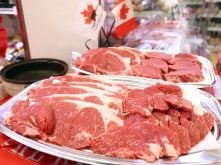Cash fed cattle markets were again surprisingly strong with packers bidding more aggressively than expected. Cull cow numbers are down and packers must turn more to fed cattle.
Futures rose with funds being attracted by technical signals.
The Canfax weighted average steer price for the week ending July 16 was $87.88 per hundredweight, up almost $2.50. Heifer average was at $87.54, up $2.78.
Fed prices are now trading above year ago levels. Feedlots are staying current and lift times appear to be getting shorter for packers.
Sales volume was 27,649 head, up 500 head from the previous week.
Read Also

More factors affecting winter weather
When you combine a weak La Niña, early Siberian snow, and a warm northern Pacific, it’s easy to see why long-range winter forecasting is so complex.
The cash to futures basis narrowed to -$8.09 from -$9.55 the previous week.
Weekly exports to July 3 totalled 9,834 head, 58 percent higher than last year.
Cow prices have turned up. D1, D2 cows were $48-$64 to average $57.78, up 78 cents. D3 cows traded $48-$57 to average $52.33, up 67 cents.
Bulls traded $60-$80, to average $71.18.
Weekly non-fed exports to the U.S. to July 3 were steady at 2,394 head. Exports are up 17 percent to date.
FEEDER TRADE QUIET
Alberta auction volumes were 12,798 head, up 36 percent from the week before but 17 percent below last year.
Despite smaller weekly volumes over the last two months, year to date volumes are up eight percent.
Auction markets are quiet with cows making up most of the trade.
Heavier cattle rose with steers and heifers 800 pounds and heavier up $1 or more.
Lighter animals were pressured moderately lower after being 12 percent higher than year ago levels for the last three weeks.
Weekly feeder exports totalled 4,639 head to July 3, double the previous week. Year to date exports are down 33 percent.
Prices for yearlings coming off grass may peak at $113 in August or September.
BEEF EDGES LOWER
U.S. Choice cutouts fell 74 cents to $153.87 US per cwt. and Select fell 26 cents to $144.79.
U.S. beef imports January to May are down 16 percent from last year while exports are up 26 percent.
U.S. beef production is expected to decline two percent in 2010 because of the smaller calf crop.
Weekly Canadian slaughter to July 10 was 66,206 head, up 11 percent.
The first half of the year saw Canadian fed slaughter up five percent while non-fed slaughter was down one percent.
Beef production is up six percent year to date. Beef imports from January to May were down six percent while exports were up 16 percent.
The Montreal wholesale market for delivery this week was steady at $175- $177.
FEW CATTLE ON FEED
The number of cattle on feed in Alberta and Saskatchewan July 1 was 787,569, down 16 percent from June 1.
That was up two percent from last year at the same time.
Good grass growth discouraged placements, which fell to 66,966, down 31 percent from a year ago and the smallest June placement number since BSE.
Fed marketings for the survey group in June were 194,786, up 14 percent from a year ago.
The total number of steers and heifers either killed domestically or exported was 224,659, up eight percent from a year ago.
This cattle market information is selected from the weekly report from Canfax, a division of the Canadian Cattlemen’s Association. More market information, analysis and statistics are available by becoming a Canfax subscriber by calling 403- 275-5110 or at www.canfax.ca.














